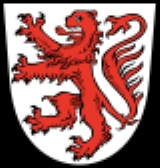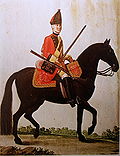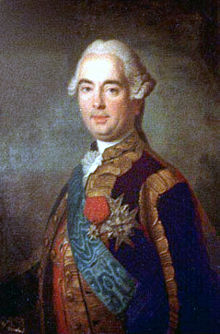
Battle of Corbach
Encyclopedia
The Battle of Corbach, or Korbach
, a Hanseatic
town of Waldeck-Frankenberg in northern Hesse, Germany, was fought on 10 July 1760 during the Seven Years' War
. Corbach was the first battle of the campaign of 1760 and was a victory for the French over the Hanoverians, the British and their allies.
marshal of France
was about 18 miles to the south at Frankenburg while the main allied force under Ferdinand, Duke of Brunswick was at Sachsenhausen 6 miles to the east. De Broglie had been ordered to advance on Hanover north through Hesse and the French at Corbach were only 25 miles west of Cassel the capital of Hesse.
Corbach itself had been previously seized on 9 July by General Nicolas Luckner
, the Hanoverian light cavalry commander, but his small force of 4 squadrons and a battalion of Hessian Jägers
was driven off very early on the 10th by the vanguard of St. Germain. Ferdinand sent Karl Wilhelm Ferdinand, the Hereditary Prince, the Erbprinz of Brunswick, with a mixed force of British, Hanoverians, Hessians and others with the intent to retake Corbach, defeat St. Germain's corps and prevent the junction of two French armies at that point. Leaving Lord Granby in command at Sachsenhausen, Ferdinand marched with a large force to Wildungen. The Erbprinz marched from Sachsenhausen and arrived before the heights of Corbach by 9 in the morning.
The British portion under the command of Major General Griffin of the allied force is stated to be at least four battalions of foot; including: Hodgson's 5th, Cornwallis' 24th, Carr's 50th, Brudenell's 51st; five squadron's of horse including three of Bland's Dragoons and 2 of Howard's; and a brigade of 18 pieces of artillery under Captain Charlton. The balance of the allied force was some nineteen battalions of Hanoverian, Hessian and Brunswick foot and fourteen squadrons of cavalry. Additionally, Luckner was still in the vicinity.
Saint Germain's command was, initially, the two brigades of de la Tour-du-Pin and la Couronne followed by the brigades Royal-Suédois and de Castella (3 Swiss regiments) reinforced later by Navarre and du Roi and is stated to be various sizes from a low of 10 battalions and fifteen squadrons, perhaps 7,000 to as many as 10,000 in six brigades and 17 squadrons.

 St. Germain deployed four infantry battalions in the town of Corbach. The rest of his corps, infantry artillery and cavalry, were drawn up on Corbach heights extending east and somewhat north to the woods of Berndorf in which he deployed some light troops. The Hereditary Prince deployed his corps and attacked immediately, however, the French deployment obliged him to leave his left rear open to an advance by any French reinforcement sent north on the road from Frankenberg to Corbach.
St. Germain deployed four infantry battalions in the town of Corbach. The rest of his corps, infantry artillery and cavalry, were drawn up on Corbach heights extending east and somewhat north to the woods of Berndorf in which he deployed some light troops. The Hereditary Prince deployed his corps and attacked immediately, however, the French deployment obliged him to leave his left rear open to an advance by any French reinforcement sent north on the road from Frankenberg to Corbach.
The battle began with the allies' arrival at 9 A.M., opening with some Hussar
light cavalry skirmishing from both sides. A heated cannonade lasted throughout the day along with brisk infantry fire with the French standing firm. The fight became particularly intense in the center in a hollow way, between two woods on the hill between Corbach and Berndorf Wood where the French put the German allied contingent into some difficulty. According to an official report from Granby to Ligonier, the arrival of French troops from Frankenberg on the allied rear decided the Prince on a withdrawal.
During the withdrawal confusion broke out in the allied German infantry and cavalry ranks the French redoubled their artillery fire and charged with a large body of cavalry. The allied retreat began around 3 in the afternoon in some disorder. Two of British cavalry squadrons of the 1st King's Regiment of Dragoon Guards and the 2nd Queen's Regiment of Dragoon Guards led by the Erbprinz charged and are credited with saving nearly the entire force, with the 1st KDG losing 47 killed. The two British cavalry regiments and two British infantry regiments, the 50th and 51st, covered the allies' retreat but could not prevent the loss of the right flank Royal Artillery Brigade and 18 guns to the French.
and Warburg
. With the French marginal victory at the Kloster Kampen
later in October any hope the British had of ending the war on favorable terms in 1760 evaporated despite their successes in America.
Korbach
Korbach is the district seat of Waldeck-Frankenberg in northern Hesse, Germany. It is over a thousand years old and a former Hanseatic town. It is located on the German Framework Road.- Geography and geology :...
, a Hanseatic
Hanseatic League
The Hanseatic League was an economic alliance of trading cities and their merchant guilds that dominated trade along the coast of Northern Europe...
town of Waldeck-Frankenberg in northern Hesse, Germany, was fought on 10 July 1760 during the Seven Years' War
Seven Years' War
The Seven Years' War was a global military war between 1756 and 1763, involving most of the great powers of the time and affecting Europe, North America, Central America, the West African coast, India, and the Philippines...
. Corbach was the first battle of the campaign of 1760 and was a victory for the French over the Hanoverians, the British and their allies.
Preliminary maneuvers
The town of Corbach is sited on the heights of Corbach that rise to some 400 meters above the surrounding plain and extend about one mile east of Corbach to the woods of Berndorf, while several roads intersect at the town itself. Numerous large forces from both sides were concentrating in this area. The main French force under Victor-François, 2nd duc de BroglieVictor-François, 2nd duc de Broglie
Victor François de Broglie, 2nd duc de Broglie was a French aristocrat and soldier and a marshal of France...
marshal of France
Marshal of France
The Marshal of France is a military distinction in contemporary France, not a military rank. It is granted to generals for exceptional achievements...
was about 18 miles to the south at Frankenburg while the main allied force under Ferdinand, Duke of Brunswick was at Sachsenhausen 6 miles to the east. De Broglie had been ordered to advance on Hanover north through Hesse and the French at Corbach were only 25 miles west of Cassel the capital of Hesse.
Corbach itself had been previously seized on 9 July by General Nicolas Luckner
Nicolas Luckner
Nikolaus, Count Luckner was a German in French service who rose to become a Marshal of France. ....
, the Hanoverian light cavalry commander, but his small force of 4 squadrons and a battalion of Hessian Jägers
Jäger (military)
Jäger is a term that was adopted in the Enlightenment era in German-speaking states and others influenced by German military practice to describe a kind of light infantry, and it has continued in that use since then....
was driven off very early on the 10th by the vanguard of St. Germain. Ferdinand sent Karl Wilhelm Ferdinand, the Hereditary Prince, the Erbprinz of Brunswick, with a mixed force of British, Hanoverians, Hessians and others with the intent to retake Corbach, defeat St. Germain's corps and prevent the junction of two French armies at that point. Leaving Lord Granby in command at Sachsenhausen, Ferdinand marched with a large force to Wildungen. The Erbprinz marched from Sachsenhausen and arrived before the heights of Corbach by 9 in the morning.
The British portion under the command of Major General Griffin of the allied force is stated to be at least four battalions of foot; including: Hodgson's 5th, Cornwallis' 24th, Carr's 50th, Brudenell's 51st; five squadron's of horse including three of Bland's Dragoons and 2 of Howard's; and a brigade of 18 pieces of artillery under Captain Charlton. The balance of the allied force was some nineteen battalions of Hanoverian, Hessian and Brunswick foot and fourteen squadrons of cavalry. Additionally, Luckner was still in the vicinity.
Saint Germain's command was, initially, the two brigades of de la Tour-du-Pin and la Couronne followed by the brigades Royal-Suédois and de Castella (3 Swiss regiments) reinforced later by Navarre and du Roi and is stated to be various sizes from a low of 10 battalions and fifteen squadrons, perhaps 7,000 to as many as 10,000 in six brigades and 17 squadrons.
The battle


The battle began with the allies' arrival at 9 A.M., opening with some Hussar
Hussar
Hussar refers to a number of types of light cavalry which originated in Hungary in the 14th century, tracing its roots from Serbian medieval cavalry tradition, brought to Hungary in the course of the Serb migrations, which began in the late 14th century....
light cavalry skirmishing from both sides. A heated cannonade lasted throughout the day along with brisk infantry fire with the French standing firm. The fight became particularly intense in the center in a hollow way, between two woods on the hill between Corbach and Berndorf Wood where the French put the German allied contingent into some difficulty. According to an official report from Granby to Ligonier, the arrival of French troops from Frankenberg on the allied rear decided the Prince on a withdrawal.
During the withdrawal confusion broke out in the allied German infantry and cavalry ranks the French redoubled their artillery fire and charged with a large body of cavalry. The allied retreat began around 3 in the afternoon in some disorder. Two of British cavalry squadrons of the 1st King's Regiment of Dragoon Guards and the 2nd Queen's Regiment of Dragoon Guards led by the Erbprinz charged and are credited with saving nearly the entire force, with the 1st KDG losing 47 killed. The two British cavalry regiments and two British infantry regiments, the 50th and 51st, covered the allies' retreat but could not prevent the loss of the right flank Royal Artillery Brigade and 18 guns to the French.
Aftermath
The battle of Corbach was the first battle of the campaign of 1760. The French success at Corbach combined with De Broglie's taking the initiative early in the season did much to enable them to continue their advance and maintain the gains they made by maneuver in Germany despite several subsequent battlefield defeats at the hands of the Hereditary Prince and Ferdinand in the battles of EmsdorfBattle of Emsdorf
The Battle of Emsdorf was fought on 14 July 1760 during the Seven Years' War at Emsdorf in present-day Hesse, Germany, between forces of British, Hanoverian and Hessian troops under the Prince of Hesse-Kassel against German troops in French service under Marechal de Camp Glaubitz...
and Warburg
Battle of Warburg
The Battle of Warburg was a battle fought on 31 July 1760 during the Seven Years' War. The Battle was a victory for the Hanoverians and the British against the French. British general John Manners, Marquess of Granby achieved some fame for charging at the head of the British cavalry and losing his...
. With the French marginal victory at the Kloster Kampen
Battle of Kloster Kampen
The Battle of Kloster Kampen was a tactical French victory over a British and allied army in the Seven Years' War. The Allied forces were driven from the field.-Prelude:...
later in October any hope the British had of ending the war on favorable terms in 1760 evaporated despite their successes in America.

